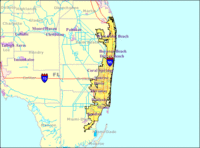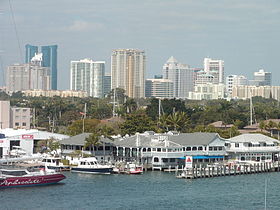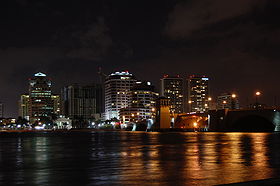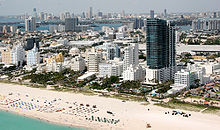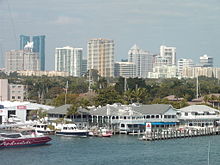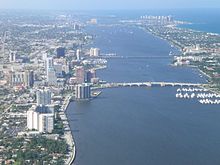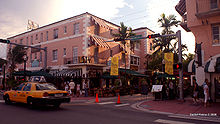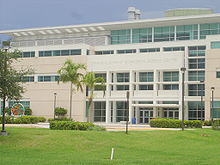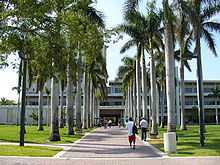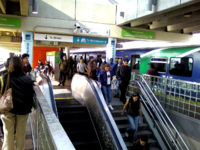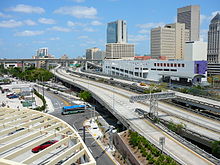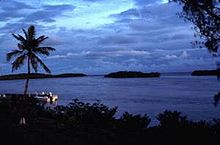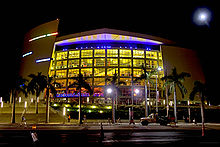- South Florida metropolitan area
-
"South Florida" redirects here. For the university in Tampa, see University of South Florida. For that school's athletic program, see South Florida Bulls.
Miami–Fort Lauderdale–Pompano Beach
Common name: South FloridaLargest city Miami Other cities - Hialeah
- Fort Lauderdale
- Pompano Beach
- Boca Raton
- West Palm Beach
- Miami Beach
- HollywoodPopulation Ranked 8th in the U.S. - Total 5,564,635 (2010) - Density 890/sq. mi.
315/km²Area 6,137 sq. mi.
15,896 km²State(s) - Florida Elevation - Highest point Coconut Grove, Miami (natural)
Greynolds Park, Miami (non-natural)[1][2]
24, 42 feet (7.3, 12.8 m)- Lowest point Atlantic Ocean
0 feet (0 m)The South Florida metropolitan area, also known as the Miami metropolitan area,[3][4][5][6] and designated the Miami–Fort Lauderdale–Pompano Beach, FL Metropolitan Statistical Area by the U.S. Office of Management and Budget,[7] is the most populous metropolis in the Southeastern United States[8] and the eighth-most populous metropolitan area in the United States, encompassing a tri-county area on the southeastern coast of the U.S. state of Florida. The metropolitan area covers the counties of Miami-Dade, Broward, and Palm Beach. The three counties are the three most populous in Florida. The term South Florida is roughly synonymous with Gold Coast. The principal cities include Miami, Fort Lauderdale, Hollywood, Pompano Beach, Boca Raton, and West Palm Beach.
Because the population of South Florida is largely confined to a strip of land between the Atlantic Ocean and the Everglades, the Miami urbanized area (that is, the area of contiguous urban development) is about 110 miles (180 km) long (north to south), but never more than 20 miles (32 km) wide, and in some areas only 5 miles (8.0 km) wide (east to west). South Florida is longer than any other urbanized area in the United States except for the New York metropolitan area.[9] It was the eighth most densely populated urbanized area in the United States in the 2000 census.[10]
As of the 2000 census, the urbanized area had a land area of 1,116 square miles (2,890 km2), with a population of 4,919,036, for a population density of 4,407.4 per square mile (1,701.7 per square kilometer). Miami and Hialeah (the second largest city in the metropolitan area) had population densities of more than 10,000 per square mile (more than 3,800 per square kilometer).[11][12] The Miami Urbanized Area was the fifth largest urbanized area in the United States in the 2000 census.
The Miami metro area also includes several urban clusters (UCs) as of the 2000 Census which are not part of the Miami Urbanized Area. These are the Belle Glade UC, population 24,218, area 20,717,433 square meters and population density of 3027.6 per square mile; Key Biscayne UC, population 10,513, area 4,924,214 square meters and population density of 5529.5 per square mile; Redland UC, population 3,936, area 10,586,212 square meters and population density of 963.0 per square mile; and West Jupiter UC, population 8,998, area 24,737,176 square meters and population density of 942.1 per square mile.[13]
In 2006, the area had an estimated 5,463,857 persons, of which 1,671,398 live in unincorporated areas.[14][15][16] Considering that the area has an urban population of 4,919,036, only 544,821 residents live outside of the urban area, meaning that at least 1,126,577 persons live in urban unincorporated areas, but the number is actually higher.
Contents
Metropolitan divisions
The Miami metropolitan area consists of three distinct metropolitan divisions, subdividing the region into three divisions according to the region's three counties: Miami-Dade County, Broward County, and Palm Beach County.
Metropolitan Divisions 2010 Census
Population2000 Census
PopulationMiami--Miami Beach—Kendall 2,496,435 2,253,362 Fort Lauderdale--Pompano Beach—Deerfield Beach 1,748,066 1,623,018 West Palm Beach--Boca Raton—Boynton Beach 1,320,134 1,131,184 Miami MSA 5,564,635 5,007,564 Cities
Largest cities
(Cities with over 100,000 inhabitants)[17]City Population County Miami 399,457 Miami-Dade Hialeah 224,669 Miami-Dade Fort Lauderdale 165,521 Broward Pembroke Pines 154,750 Broward Hollywood 140,768 Broward Miramar 122,041 Broward Coral Springs 121,096 Broward Miami Gardens 107,167 Miami-Dade Principal cities
Principal cities are defined by the Census Bureau based on population size and employment. In general, a principal city has more non-residents commuting into the city to work than residents commuting out of the city to work.[18] As of December 2009, the Census Bureau defined the following principal cities in the metropolitan area:[19]
- Miami
- Fort Lauderdale
- Pompano Beach
- West Palm Beach
- Miami Beach
- Kendall
- Boca Raton
- Deerfield Beach
- Boynton Beach
- Delray Beach
- Homestead
Areas with between 10,000 and 100,000 inhabitants
Areas with fewer than 10,000 inhabitants
Demographics
Population
Historical populations Census Pop. %± 1900 4,955 — 1910 17,510 253.4% 1920 66,542 280.0% 1930 214,830 222.8% 1940 387,522 80.4% 1950 693,705 79.0% 1960 1,497,099 115.8% 1970 2,236,645 49.4% 1980 3,220,844 44.0% 1990 4,056,100 25.9% 2000 5,007,564 23.5% 2010 5,564,635 11.1% South Florida is a very diverse community with much of the population coming from all over Latin America and the Caribbean, Europe, Canada, and Asia.[citation needed]
Another large factor are residents who were former snowbirds from the Northeast. Many of them come from a variety of age-ranges, mostly retirees, and tend to be American Jews, American Muslims, Italian Americans, Irish Americans, African American, Nicaraguan American, Stateside Puerto Ricans, Dominican Americans, and other second and third-generation Americans.[citation needed]
To a lesser extent, snowbirds are also from the Midwest (mostly Ohio, Illinois, and Michigan) and West Coast (mainly California,) as well as the South and the Pacific Northwest.[citation needed]
Politically speaking, South Florida is heavily Democratic. Broward County is the second most reliably Democratic county in the state,[20][21] behind only Gadsden County (where African Americans make up the majority). Palm Beach County, like Broward, is largely Democratic as well, especially amongst its Jewish community,[22] while the rest of Florida tends to follow Southern politics and vote more Republican, with the exception of certain parts of Florida where Southern culture is not as influential. With a majority Hispanic population in Miami-Dade, Republican votes are mainly by older generations of Cuban Americans most of whom had fled to the United States to escape the Communist reign of Fidel Castro, but Miami-Dade County still remains very Democratic when compared with most of Florida's other counties.[23][24][25]
As of the 2005 American Community Survey[26][27] there is a total of 5,334,685 people living in the metropolis.
South Florida has a very large Jewish community; 10.2% of the population was Jewish in the 2000 Census.[citation needed] There is also a sizable Muslim community numbering at 70,000 some of whom are American born converts to Islam.[28]
Population: As of the 2005 U.S. Census, there were 5,334,685 people. 2.8 million (52%) were females and 2.6 million (48%) were males. The median age was 38.6 years. 24% of the population were under 18 years and 15% were 65 years and older. There were 2,338,450 households, and 1,326,391 families residing in the South Florida metropolitan area.
Ethnicity:
The racial makeup of population of South Florida [5,334,685] as of 2005:[29]- White: 72% [3,840,973]
- White Non-Hispanic: 39% [2,080,527]
- White Hispanic: 33% [1,760,446]
- Black or African American (many from the Caribbean): 21% [1,075,174]
- Native American: less than 0.5% [10,582]
- Asian (many of Indo-Caribbean, Asian Latino and Chinese Caribbean origin): 2% [111,196]
- Pacific Islander: less than 0.5% [3,346]
- Other races: 5% [286,399]
- Two or more races: 2% [91,520]
- Hispanic or Latino of any race were 38% [2,013,725] of the population
Language and national origin
National origin and language: Of the people living in the South Florida metro area in 2005, 63% were born in the United States (including 30% who were born in Florida) and 37% were foreign born. Among people at least five years old living in South Florida in 2005, 52% spoke English at home while 48% spoke some other language at home. Of those speaking a language other than English at home, 78% spoke Spanish and 22% spoke some other language (mainly Haitian Creole, but also French, German, Hebrew, Italian, Portuguese, Russian or Yiddish). About 47% reported that they did not speak English "very well."
Geographic mobility: In 2005, 83% of the people at least one year old living in the South Florida metro area were living in the same residence one year earlier; 12% had moved during the past year from another residence in the same county, 2% from another county in the same state, 2% from another state, and 1% from abroad.
Households and families: There were 2,338,450 households, The average household size was 2.6 people. Families made up 65% of the households in South Florida. This figure includes both married-couple families (45%) and other families (20%). Nonfamily households made up 35% of all households in South Florida. Most of the nonfamily households were people living alone, but some consisted of people living in households in which no one was related to the householder.
Education
Education: In 2005, 83% of people 25 years and over had at least graduated from high school and 30% had a bachelor's degree or higher. Among people 16 to 19 years old, 7% were dropouts; they were not enrolled in school and had not graduated from high school. The total school enrollment in South Florida Metro Area was 1.4 million in 2005. Nursery school and kindergarten enrollment was 170,000 and elementary or high school enrollment was 879,000 children. College or graduate school enrollment was 354,000.
Occupation, Income, and Industries
- See also: List of companies in South Florida
 The urban neighborhood of Brickell in Downtown Miami contains the largest concentration of international banks in the U.S.
The urban neighborhood of Brickell in Downtown Miami contains the largest concentration of international banks in the U.S.
Occupations and Type of Employer: Among the most common occupations were: 32% were management, professional, and related occupations, 30% were sales and office occupations, 18% were service occupations, 11% were construction, extraction, maintenance and repair occupations, and 9% were production, transportation, and material moving occupations. 81% of the people employed were Private wage and salary workers; 12% were Federal, state, or local government workers; and 7% were Self-employed in own not incorporated business workers.
Income: The median income of households in South Florida was $43,091. 78% of the households received earnings and 13% received retirement income other than Social Security. 30% of the households received Social Security. The average income from Social Security was $13. These income sources are not mutually exclusive; that is, some households received income from more than one source.
Industries: In 2005, for the employed population 16 years and older, the leading industries in South Florida Area were Educational services, health care and social assistance, which accounted for 18%, and Professional, scientific, and management, and administrative and waste management services, which accounted for 13% of the population.
Traveling to Work: 79% of South Florida workers drove to work alone in 2005, 10% carpooled, 4% took public transportation, and 4% used other means. The remaining 3% worked at home. Among those who commuted to work, it took them on average 28.5 minutes to get to work.
Poverty and Participation in Government Programs: In 2005, 14% of people were in poverty. 19% of related children under 18 were below the poverty level, compared with 14% of people 65 years old and over. 11% of all families, and 26% of families with a female householder and no husband present had incomes below the poverty level.
Housing characteristics and costs
Housing characteristics: As of 2005, South Florida had a total of 2.3 million housing units, 13% of which were vacant. Of the total housing units, 52% were in single-unit structures, 45% were in multi-unit structures, and 3% were mobile homes. 25% of the housing units were built since 1990.
Occupied housing unit characteristics: In 2005, South Florida had 2.0 million occupied housing units – 1.3 million (66%) owner occupied and 688,000 (34%) renter occupied.
Housing costs: In 2010, housing costs in South Florida typically represented 40% of household income, compared to 34% nationwide.[30]
Property tax increase: In March 2009, South Florida lawmakers passed a 5–10% hike in property tax millage rates throughout the metropolitan area to fund the construction of new schools and to fund understaffed schools and educational institutions, resulting in an increase in residents' property tax bills beginning in the 2009 tax year.
Education
In Florida, each county is also a school district. Each district is headed by an elected school board. A professional superintendent manages the day-to-day operations of each district, who is appointed by and serves at the pleasure of the School Board.
The Miami-Dade County Public School District is currently the 4th-largest public school district in the nation. The School District of Palm Beach County is the 4th-largest in Florida and the 11th-largest in the United States. Broward County Public School District is the 6th-largest in the United States.
Some colleges and universities in South Florida include:
- Barry University (private/Catholic)
- Broward College (public)
- Carlos Albizu University (private)
- Florida Atlantic University (public)
- Florida International University (public)
- Florida Memorial University (private)
- Johnson & Wales University (private)
- Le Cordon Bleu College of Culinary Arts Miami (private)
- Lynn University (private)
- Miami Dade College (public)
- Northwood University (private)
- Nova Southeastern University (private)
- Palm Beach Atlantic University (private/Christian)
- Palm Beach State College (public)
- St. Thomas University (private/Catholic)
- University of Miami (private)
In 2005, 82% of people 25 years and over had at least graduated from high school and 28% had a bachelor's degree or higher. Among people 16 to 19 years old, 7% were dropouts; they were not enrolled in school and had not graduated from high school. The total school enrollment in South Florida metro area was 1.4 million in 2005. Nursery school and kindergarten enrollment was 170,000 and elementary or high school enrollment was 879,000. College or graduate school enrollment was 354,000.
Transportation
Roads
The South Florida metropolitan area is served by five interstate highways operated by the Florida Department of Transportation (FDOT) in conjunction with local agencies. Interstate 95 (I-95) runs north to south along the coast, ending just south of Downtown Miami at South Dixie Highway (US 1). I-75 runs east to west, turning south in western Broward County and connecting suburban north Miami-Dade to Naples on the Southwest Coast via Alligator Alley, which transverses the Florida Everglades before turning north. I-595 connects the Broward coast and downtown Fort Lauderdale to I-75 and Alligator Alley. In Miami, I-195 and I-395 relay the main I-95 route east to Biscayne Boulevard (US 1) and Miami Beach across Biscayne Bay via the Julia Tuttle and MacArthur causeways.
In greater Miami, the Miami-Dade Expressway Authority and Florida's Turnpike Enterprise (FTE) maintain eight state expressways in conjunction with FDOT. The Airport Expressway (SR 112) and the Dolphin Expressway (SR 836) relay western Miami-Dade suburbs to the eastern urban coast at I-95, and to Miami Beach via I-195 and I-395 at the Airport and Midtown interchanges. The Gratigny Expressway (SR 924) connects northern Miami suburbs to the southern end of I-75. The Palmetto Expressway (SR 826) is the primary beltway road of urban Miami, relaying I-95 and Florida's Turnpike at the Golden Glades Interchange near northeastern North Miami Beach to the southern inland suburbs of Kendall and Pinecrest. The Don Shula Expressway (SR 874) and the Homestead Extension of Florida's Turnpike (SR 821) form the southernmost end of the beltway, connecting the Palmetto Expressway to the bedroom communities of Homestead and Florida City. The Snapper Creek Expressway (SR 878) relays the Don Shula Expressway to South Dixie Highway (US 1).
The urban bypass expressway in greater Fort Lauderdale is the Sawgrass Expressway (SR 869), connecting the northern Broward County coast at I-95 and Deerfield Beach to I-595 and I-75 at Alligator Alley in Sunrise.
Major freeways and tollways
 Interstate 95
Interstate 95 Interstate 75
Interstate 75 Interstate 195
Interstate 195 Interstate 395
Interstate 395 Interstate 595
Interstate 595 Florida's Turnpike
Florida's Turnpike Homestead Extension of Florida's Turnpike
Homestead Extension of Florida's Turnpike Dolphin Expressway (State Road 836)
Dolphin Expressway (State Road 836) Gratigny Parkway (State Road 924)
Gratigny Parkway (State Road 924) Airport Expressway (State Road 112)
Airport Expressway (State Road 112) Don Shula Expressway (State Road 874)
Don Shula Expressway (State Road 874) Snapper Creek Expressway (State Road 878)
Snapper Creek Expressway (State Road 878) Sawgrass Expressway (State Road 869)
Sawgrass Expressway (State Road 869) Palmetto Expressway (State Road 826)
Palmetto Expressway (State Road 826) Hialeah Expressway (State Road 934)
Hialeah Expressway (State Road 934) Downtown Distributor (State Road 970)
Downtown Distributor (State Road 970)
Major airports
The metropolitan area is served by three major commercial airports. These airports combine to make the fourth largest domestic origin and destination market in the United States, after New York City, Los Angeles, and Chicago.[31]
Airport IATA code ICAO code County State Miami International Airport MIA KMIA Miami-Dade Florida Fort Lauderdale – Hollywood International Airport FLL KFLL Broward Florida Palm Beach International Airport PBI KPBI Palm Beach Florida The following smaller general aviation airports are also in the metro area:
Airport IATA code ICAO code County State Dade-Collier Training and Transition Airport TNT KTNT Miami-Dade Florida Homestead General Aviation Airport Miami-Dade Florida Homestead Joint Air Reserve Base HST KHST Miami-Dade Florida Kendall-Tamiami Executive Airport TMB KTMB Miami-Dade Florida Opa-locka Airport OPF KOPF Miami-Dade Florida Fort Lauderdale Executive Airport FXE KFXE Broward Florida North Perry Airport HWO KHWO Broward Florida Pompano Beach Airpark PPM KPMP Broward Florida Boca Raton Airport BCT KBCT Palm Beach Florida North Palm Beach County General Aviation Airport Palm Beach Florida Palm Beach County Park Airport LNA KLNA Palm Beach Florida Seaports
The metropolis also has four seaports, the largest and most important being the Port of Miami. Others in the area include Port Everglades, Port of Palm Beach and the Miami River Port.
Public transportation
Miami-Dade Transit (MDT) is the largest public transit agency in Florida, operating rapid transit, people movers, and an intercity bus system. Metrorail is Florida's only rapid transit, currently with 22 stations on a 22.4-mile (36.0 km) track, and expanding to 23 stations and a 24.9-mile (40.1 km) track upon the completion of Miami Central Station at Miami International Airport in 2012. The Downtown Miami people mover, Metromover, operates 21 stations and three lines on a 4.4-mile (7.1 km) track through the Downtown neighborhoods of the Omni, the central Downtown, and Brickell. Metrobus is serves the entirety of Miami-Dade County, also serving Monroe County as far south as Marathon, and Broward County as far north as downtown Fort Lauderdale. In Broward County, Broward County Transit runs public buses, as does Palm Tran in Palm Beach County. Additionally, the South Florida Regional Transportation Authority operates Tri-Rail, a commuter rail train that connects the three of the primary cities of South Florida (Miami, Fort Lauderdale, and West Palm Beach), and most intermediate points.
Climate
South Florida has a tropical climate, the only major metropolitan area in the 48 contiguous states that falls under that category. More specifically, it generally has a tropical monsoon climate (Köppen climate classification, Am).[32] The metropolis does experience cold fronts from November through March, however most of the year is warm and humid and the mean temperature for any month is never below 64.4 °F (18 °C). In addition, the metropolis sees most of its rain in the summer (wet season) and is mainly dry in winter (dry season). The wet season, which is hot and humid, lasts from May to October, when it gives way to the dry season, which features mild temperatures with some invasions of colder air, which is when the little winter rainfall occurs – with the passing of a front. The hurricane season largely coincides with the wet season.[33]
In addition to its sea-level elevation, coastal location and position just above the Tropic of Cancer, the area owes its warm, humid climate to the Gulf Stream, which moderates climate year-round. A typical summer day does not see temperatures below 75 °F (24 °C). Temperatures in the high 80s to low 90s (30–35 °C) accompanied by high humidity are often relieved by afternoon thunderstorms or a sea breeze that develops off the Atlantic Ocean, which then allow lower temperatures, although conditions still remain very muggy. During winter, humidity is significantly lower, allowing for cooler weather to develop. Average minimum temperatures during that time are generally in the 50s to around 60 °F (10–15 °C), occasionally dipping into the 40s (5–9 °C) and rarely below 35 °F (2 °C). The average maximum for South Florida during the winter is around 75 °F (24 °C).
Hurricane season officially runs from June 1 through November 30, although hurricanes can develop outside that period. The most likely time for South Florida to be hit is during the peak of the Cape Verde season, mid-August through the end of September.[34] Due to its location between two major bodies of water known for tropical activity, South Florida is also statistically the most likely major area to be struck by a hurricane in the world, trailed closely by Nassau, Bahamas, and Havana, Cuba. Many hurricanes have affected the metropolis, including Betsy in 1965, Andrew in 1992, Irene in 1999, and Hurricanes Katrina and Wilma in 2005. In addition, a tropical depression in October 2000 passed over the city, causing record rainfall and flooding. Locally, the storm is credited as the No Name Storm of 2000, though the depression went on to become Tropical Storm Leslie upon entering the Atlantic Ocean.
Area codes
- 305 and 786 Miami-Dade County and Florida Keys
- 954 Broward County
- 754 Broward County
- 561 Palm Beach County
Sports
- The Florida Marlins of Major League Baseball and the Miami Dolphins of the National Football League play at Sun Life Stadium in Miami Gardens, Florida.
- The Miami Heat of the National Basketball Association play at AmericanAirlines Arena in Downtown Miami.
- The Florida Panthers of the National Hockey League play at BankAtlantic Center in Sunrise.
- The Fort Lauderdale Strikers of the North American Soccer League play at Lockhart Stadium in Fort Lauderdale.
- The Florida Marlins and St. Louis Cardinals conduct Spring Training in Jupiter at Roger Dean Stadium.
- The Baltimore Orioles conduct Spring training in Fort Lauderdale at Fort Lauderdale Stadium.
- The Miami metro area also hosts the college sports teams of Barry University, Florida Atlantic University, Florida International University (FIU Stadium, U.S. Century Bank Arena and University Park Stadium), Nova Southeastern University and University of Miami (Sun Life Stadium, BankUnited Center and Mark Light Field).
Government
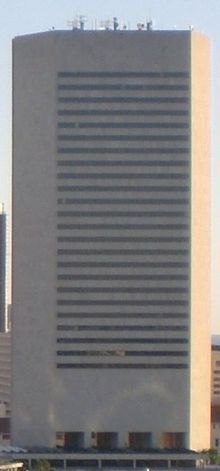 The Stephen P. Clark Government Center in Downtown Miami is the headquarters of the Miami-Dade County government.
The Stephen P. Clark Government Center in Downtown Miami is the headquarters of the Miami-Dade County government.
The metropolis is governed by the 3 counties in the area. In total there are 107 municipalities or incorporated places in the metropolis. Each one of the municipalities has its own city, town or village government, although there is no distinction between the 3 names. Much of the land in the metropolis is unincorporated, which means it does not belong to any municipality, and therefore is governed directly by the county it is located in.
Congressional districts
South Florida has all or part of nine congressional districts of which four are Republican leaning district (16th, 18th, 21st and 25th) and five are Democratic leaning districts (17th, 19th, 20th, 22nd and 23rd). District 16 is the most Republican leaning district in the area, while District 17 is the most Democratic leaning district in the region.
The Cook Political report lists District 21 as "leans Republican" while District 18 and District 25 are listed as "likely Republican."[35] Other independent political analysts including the Rotherberg Political Report,[36] CQ Politics[37] and the Crystal Ball[38] rate all three South Florida Republican districts as either "Lean Republican," "Likely Republican," "Republican Favored," "Limited Risk" or "Safe Republican." None of the districts are listed in the toss-up column. All of the Democrat seats in South Florida are listed as either "Safe Democrat," "Democrat Favored" or "Limited risk."
According to the August 14, 2008 Time magazine article, "Democrats are mounting serious challenges to at least two of Miami's three Republican lawmakers" and that "the Miami challenges have caught the GOP off guard. Democratic voter registration in Miami-Dade County, as in other places, is up, and Republican registration is down."[39]
Media
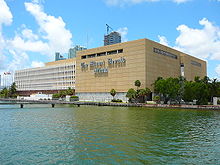 The Miami Herald headquarters in Downtown Miami. The Miami Herald is the largest newspaper in South Florida.
The Miami Herald headquarters in Downtown Miami. The Miami Herald is the largest newspaper in South Florida.
South Florida is served by several English-language and two major Spanish-language daily newspapers. The Miami Herald, headquartered in Downtown Miami, is Miami's primary newspaper with over a million readers. It also has news bureaus in Broward County, Monroe County, and Nassau, Bahamas. The South Florida Sun-Sentinel circulates primarily in Broward and southern Palm Beach counties and also has a news bureau in Havana, Cuba. The Palm Beach Post serves mainly Palm Beach County, especially the central and northern regions, and the Treasure Coast. The Boca Raton News publishes five days a week and circulates in southern Palm Beach County.[40] El Nuevo Herald, a subsidiary of the Miami Herald, and Diario Las Americas,[41] are Spanish-language daily papers that circulate mainly in Miami-Dade County. La Palma and El Sentinel are weekly Spanish newspapers published by the Palm Beach Post and Sun-Sentinel, respectively, and circulate in the same areas as their English-language counterparts.
South Florida is split into two separate television/radio markets: The Miami-Fort Lauderdale market serves Miami-Dade, Broward and the Florida Keys. The West Palm Beach market serves Palm Beach County and the Treasure Coast region.
Miami-Fort Lauderdale is the 12th largest radio market and the 17th-largest television market in the U.S. television stations serving the Miami-Fort Lauderdale area include WAMI-TV (TeleFutura), WBFS-TV (MyNetworkTV), WSFL-TV (The CW), WFOR-TV (CBS), WHFT-TV (TBN), WLTV (Univision), WPLG (ABC), WPXM (ION), WSCV (Telemundo), WSVN (FOX), WTVJ (NBC), WLRN-TV (PBS), and WPBT (also PBS), the latter television station being the only channel to serve the entire metropolitan area.
In addition to the Miami-Fort Lauderdale market, West Palm Beach has its own. It is the 49th largest radio market and the 38th-largest television market in the U.S. Television stations serving the West Palm Beach area include WPTV (NBC), WPEC (CBS), WPBF (ABC), WFLX (FOX), WTVX (The CW), WXEL (PBS), WTCN (MyNetworkTV), and WPXP (ION). The West Palm Beach market shares use of WSCV and WLTV for Telemundo and Univision respectively. Also, both markets cross over and tend to be available interchangeably between both areas.
See also
References
- ^ Miami Rock Ridge
- ^ Dean Whitman (September 1997). "Notes on the geology and Water Resources of South Florida". Notes on Florida Geology. Florida International University. http://www2.fiu.edu/~whitmand/Courses/Fl_geo_notes.html. Retrieved January 11, 2011.
- ^ Williams, Darlene F. (2005). "Proposed Metropolitan Area Definitions for FY2006 Income Limits and Estimates of Median Family Income". Federal Register: 74988–74993. http://federalregister.gov/a/05-24115. Retrieved January 12, 2011.
- ^ John Mark Ockerbloom (January 1, 2011). "Miami Metropolitan Area (Fla.)". The Online Books Page. University of Pennsylvania. http://onlinebooks.library.upenn.edu/webbin/book/browse?type=lcsubc&key=Miami%20Metropolitan%20Area%20%28Fla.%29&c=x. Retrieved January 12, 2011.
- ^ "CONSUMER EXPENDITURES FOR THE MIAMI AREA: 2008–09". News Release. United States Department of Labor (Bureau of Labor Statistics). October 28, 2010. http://www.bls.gov/ro4/cexmiam.pdf. Retrieved January 12, 2011.
- ^ "Journey-To-Work Trends in the United States and its Major Metropolitan Areas 1960–1990". Research and Innovative Technology Administration National Transportation Library. Federal Highway Administration. June 2003. http://ntl.bts.gov/DOCS/473.html. Retrieved January 12, 2011.
- ^ "Metropolitan and micropolitan statistical areas defined by the Office of Management and Budget, November 2007". Census.gov. February 8, 2011. http://www.census.gov/population/www/metroareas/lists/2007/List2.txt. Retrieved November 8, 2011.
- ^ "http://www.census.gov/popest/metro/files/2009/CBSA-EST2009-alldata.csv" (CSV). 2009 Population Estimates. United States Census Bureau. July 1, 2009. http://www.census.gov/popest/metro/files/2009/CBSA-EST2009-alldata.csv. Retrieved April 28, 2010.
- ^ PDFMiami-Fort Lauderdale-West Palm Beach: Linear & Visionless – retrieved August 2, 2006
- ^ USA Urbanized Areas Over 500,000: 2000 Rankings – Rank by Density – URL retrieved September 5, 2006
- ^ Lists of Census 2000 Urbanized Areas and Urban Clusters – URL retrieved August 27, 2006
- ^ NOTE: large (2.8 MB) PDF file – UMiami, florida Urbanized Area Outline Map, 2000 Census – URL retrieved August 27, 2006
- ^ State-sorted list for UCs – URL retrieved August 27, 2006
- ^ "CTYPFL07_rev.xls" (PDF). http://www.pbcgov.com/pzb/Planning/population/countyprofile.pdf. Retrieved November 8, 2011.
- ^ [1][dead link]
- ^ "Population Served by Local Governments". Co.hernando.fl.us. January 4, 2006. http://www.co.hernando.fl.us/plan/abstr2006/stat102b.htm. Retrieved November 8, 2011.
- ^ "Census 2010: Florida". USA Today. http://www.usatoday.com/news/nation/census/profile/FL. Retrieved November 8, 2011.
- ^ Census Bureau Geographic Concepts – retrieved July 2, 2009
- ^ Metropolitan and micropolitan statistical areas defined by the Office of Management and Budget, December 2009 – retrieved July 22, 2011
- ^ State:Broward Power. St. Petersburg Times. Retrieved November 14, 2006.
- ^ 2008 General Election Results. South Florida Sun-Sentinel. Retrieved November 11, 2008.
- ^ "sun-sentinel.com Election 2008 (Florida Presidential election results): 2008". Weblogs.sun-sentinel.com. November 4, 2008. http://weblogs.sun-sentinel.com/news/politics/palm/blog/2008/11/jewish_vote_goes_to_barack_oba.html. Retrieved November 8, 2011.
- ^ "South Florida Sun-Sentinel.com Election 2008 (Florida Presidential election results): 2008". Sun-sentinel.com. http://www.sun-sentinel.com/broadband/theedge/sfl-spreselect,0,7664639.htmlpage. Retrieved November 8, 2011.
- ^ "Election 2004 (Florida Presidential election results): 2004". CNN. April 13, 1970. http://www.cnn.com/ELECTION/2004/pages/results/states/FL/P/00/map.html. Retrieved November 8, 2011.
- ^ "Election 2006 (Florida Gubernatorial election results): 2006". CNN. http://www.cnn.com/ELECTION/2006/pages/results/states/FL/G/00/map.html. Retrieved November 8, 2011.
- ^ American Community Survey – URL retrieved January 4, 2007
- ^ American Community Survey: Narrative Profile – URL retrieved August 27, 2007
- ^ "S. Fla's 70,000 Muslims start holy month of Ramadan", The Miami Herald: p. B3, August 22, 2009
- ^ American FactFinder, United States Census Bureau. "and Housing Narrative Profile: 2005". Factfinder.census.gov. http://factfinder.census.gov/servlet/NPTable?_bm=y&-geo_id=31000US33100&-qr_name=ACS_2005_EST_G00_NP01&-gc_url=&-ds_name=&-_lang=en&-redoLog=false. Retrieved November 8, 2011.
- ^ Hanks, Douglas (October 29, 2010), "Housing costs higher in South Florida", The Miami Herald, http://www.miamiherald.com/2010/10/29/1897820/housing-costs-higher-in-south.html, retrieved February 22, 2011
- ^ http://www.eclatconsulting.com/im_pdf/top_200_us_markets.pdf
- ^ Köppen Climate Classification Map: South Florida=Aw=tropical wet & dry
- ^ Climate Zones of the World, under Koppen's System. Retrieved August 8, 2006.
- ^ Weather.com Vulnerable cities: Miami, Florida. Retrieved February 19, 2006.
- ^ Cook Political Report, as of July 31, 2008
- ^ Rothenberg Political Report, as of July 29, 2008
- ^ Livingston, Abby. "CQ Politics". CQ Politics. http://www.cqpolitics.com/wmspage.cfm?docID=ratings-house. Retrieved November 8, 2011.
- ^ Crystal Ball, as of July 30, 2008
- ^ Time Magazine, Big Trouble in Little Havana by Tim Padgett, August 14, 2008.
- ^ Boca Raton News home page – URL retrieved August 19, 2006
- ^ "Diario Las Americas". Diario Las Americas. August 2, 2010. http://www.diariolasamericas.com/. Retrieved November 8, 2011.
External links
South Florida metropolitan area Largest city Counties
(by population)Cities and towns
100k-250kCities and towns
25k-99kAventura • Boca Raton • Boynton Beach • Coconut Creek • Cooper City • Coral Gables • Dania Beach • Davie • Deerfield Beach • Delray Beach • Doral • Greenacres • Hallandale Beach • Homestead • Jupiter • Lake Worth • Lauderdale Lakes • Lauderhill • Margate • Miami Beach • North Lauderdale • North Miami • North Miami Beach • Oakland Park • Palm Beach Gardens • Plantation • Riviera Beach • Sunrise • Tamarac • West Park • Weston • Wilton ManorsCities and towns
10k-25kCity of Miami Accent • Arts • Climate • Companies • Downtown • Education • Fire • Government • Historic Landmarks • History • Library • Mayors • Miamians • Music • Neighborhoods • Police • Skyscrapers • Sports • Television • Transportation
 State of Florida
State of FloridaTopics - Delegations
- Environment
- Floridians
- Geography
- Government
- History
- State Parks
- Transportation
- Visitor Attractions
Society - Culture
- Crime
- Demographics
- Economy
- Education
- Politics
Regions Metro areas - Miami–Fort Lauderdale–Pompano Beach (Miami-Dade, Broward, Palm Beach)
- Tampa-St. Petersburg-Clearwater (Hernando, Hillsborough, Pasco, Pinellas)
- Orlando-Kissimmee-Sanford (Lake, Orange, Osceola, Seminole)
- Jacksonville (Duval, Clay, St. Johns, Nassau, Baker)
- North Port–Bradenton–Sarasota (Manatee, Sarasota)
- Cape Coral-Fort Myers (Lee)
- Lakeland-Winter Haven (Polk)
- Palm Bay-Melbourne-Titusville (Brevard)
- Deltona-Daytona Beach-Ormond Beach (Volusia)
- Pensacola-Ferry Pass-Brent (Escambia, Santa Rosa)
- Port St. Lucie (St. Lucie, Martin)
- Tallahassee (Gadsden, Jefferson, Leon, Wakulla)
- Ocala (Marion)
- Naples-Marco Island (Collier)
- Gainesville (Alachua, Gilchrist)
- Fort Walton Beach-Crestview-Destin (Okaloosa)
- Panama City-Lynn Haven-Panama City Beach (Bay)
- Punta Gorda (Charlotte)
- Sebastian-Vero Beach (Indian River)
- Palm Coast (Flagler)
Largest cities Counties - Alachua
- Baker
- Bay
- Bradford
- Brevard
- Broward
- Calhoun
- Charlotte
- Citrus
- Clay
- Collier
- Columbia
- DeSoto
- Dixie
- Duval
- Escambia
- Flagler
- Franklin
- Gadsden
- Gilchrist
- Glades
- Gulf
- Hamilton
- Hardee
- Hendry
- Hernando
- Highlands
- Hillsborough
- Holmes
- Indian River
- Jackson
- Jefferson
- Lafayette
- Lake
- Lee
- Leon
- Levy
- Liberty
- Madison
- Manatee
- Marion
- Martin
- Miami‑Dade
- Monroe
- Nassau
- Okaloosa
- Okeechobee
- Orange
- Osceola
- Palm Beach
- Pasco
- Pinellas
- Polk
- Putnam
- Santa Rosa
- Sarasota
- Seminole
- St. Johns
- St. Lucie
- Sumter
- Suwannee
- Taylor
- Union
- Volusia
- Wakulla
- Walton
- Washington
50 largest metropolitan statistical areas in the United States by population - New York
- Los Angeles
- Chicago
- Dallas–Fort Worth
- Philadelphia
- Houston
- Washington
- Miami
- Atlanta
- Boston
- San Francisco–Oakland
- Detroit
- Riverside–San Bernardino
- Phoenix
- Seattle
- Minneapolis–St. Paul
- San Diego
- St. Louis
- Tampa–St. Petersburg
- Baltimore
- Memphis
- Louisville
- Richmond
- Oklahoma City
- Hartford
- New Orleans
- Buffalo
- Raleigh
- Birmingham
- Salt Lake City
Categories:- South Florida metropolitan area
- Broward County, Florida
- Metropolitan areas of Florida
- Miami-Dade County, Florida
- Palm Beach County, Florida
Wikimedia Foundation. 2010.

